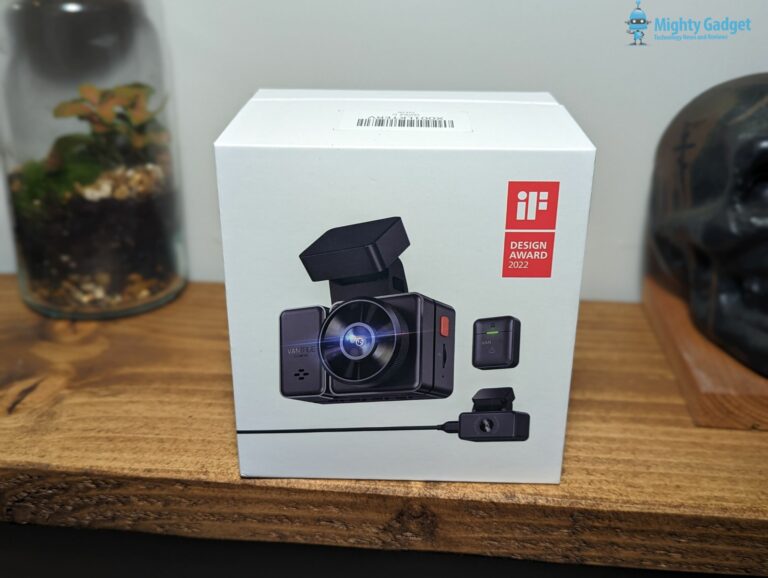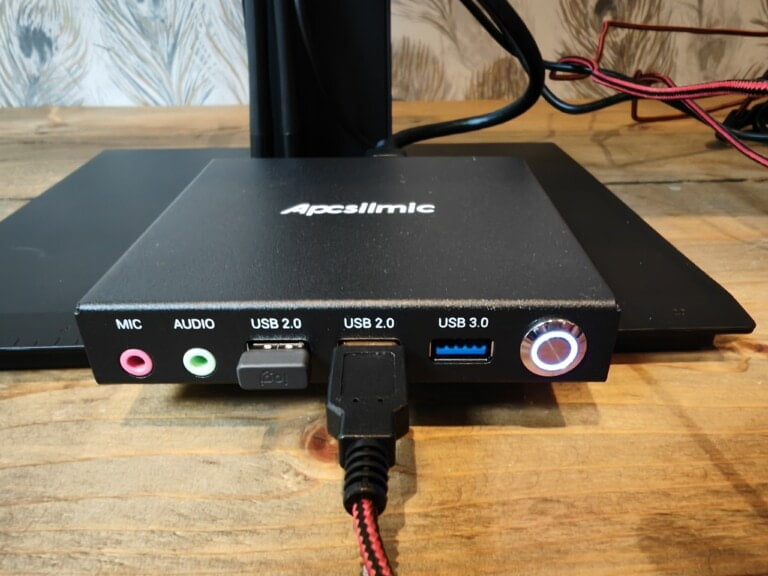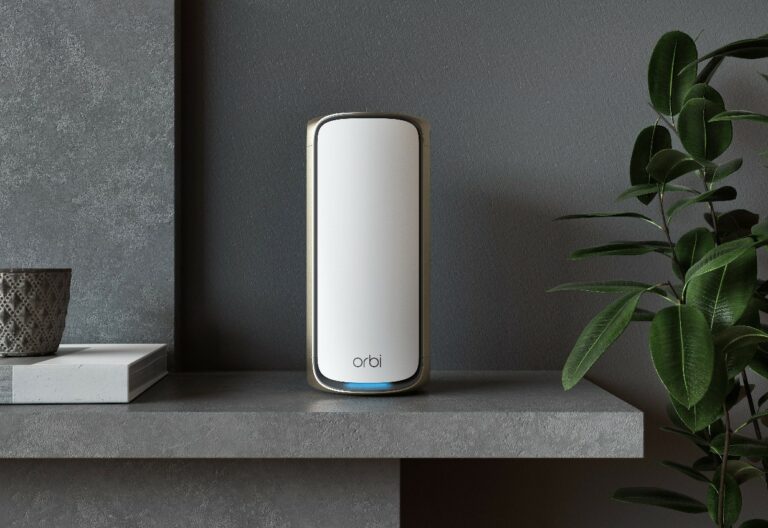Any links to online stores should be assumed to be affiliates. The company or PR agency provides all or most review samples. They have no control over my content, and I provide my honest opinion.
The Samsung Galaxy S21 Ultra officially launches today, but many pre-orders were sent out early, including mine.
The new Samsung Galaxy S21 series features the Exynos 2100 which has the potential to put Samsung back on track with their Exynos chipsets following a few years of poor performance vs its Qualcomm counterpart.
So, will UK buyers finally stop complaining about their Exynos equipped Samsung phones or will we still be left lusting after the US Qualcomm variant?
Samsung Exynos 2100 vs Qualcomm Snapdragon 888 vs Exynos 990 Specification
| SoC | Exynos 990 | Exynos 2100 | Snapdragon 888 |
|---|---|---|---|
| CPU | 2x Exynos M5 @ 2.73GHz | 1x ARM Cortex X1 @ 2.9GHz | 1x ARM Cortex-X1 @ 2.84 GHz |
| 2x ARM Cortex A76 @ 2.50GHz | 4x ARM Cortex A55 @ 2.2GHz | 3x ARM Cortex-A78 @ 2.42 GHz | |
| 4x ARM Cortex A55 @ 2.00GHz | 4x ARM Cortex-A55 @ 1.8 GHz | 4x ARM Cortex-A55 @ 1.8 GHz | |
| GPU | ARM Mali-G77MP11 | ARM Mali-G78MP14 | Qualcomm Adreno 660 +35% perf vs SD865 |
| Process | TSMC 7nm | Samsung 5nm (5LPE) | Samsung 5nm (5LPE) |
Samsung Exynos 2100 vs Qualcomm Snapdragon 888 Benchmarks
I have reused many of my tables for these benchmarks, so you have a few devices to compare.
I have not personally used:
- Huawei Mate 40 Pro
- Asus ROG Phone 3
- Samsung Galaxy S20+ 5G
I have taken the official score from the website of the respective benchmark. The three phones provide a good comparison of what’s improved with the Exynos 2100 and how it competes with the other flagship chipsets we will see in 2021.
Samsung Exynos 2100 vs Qualcomm Snapdragon 888 vs Exynos 990 Antutu Benchmarks Compared
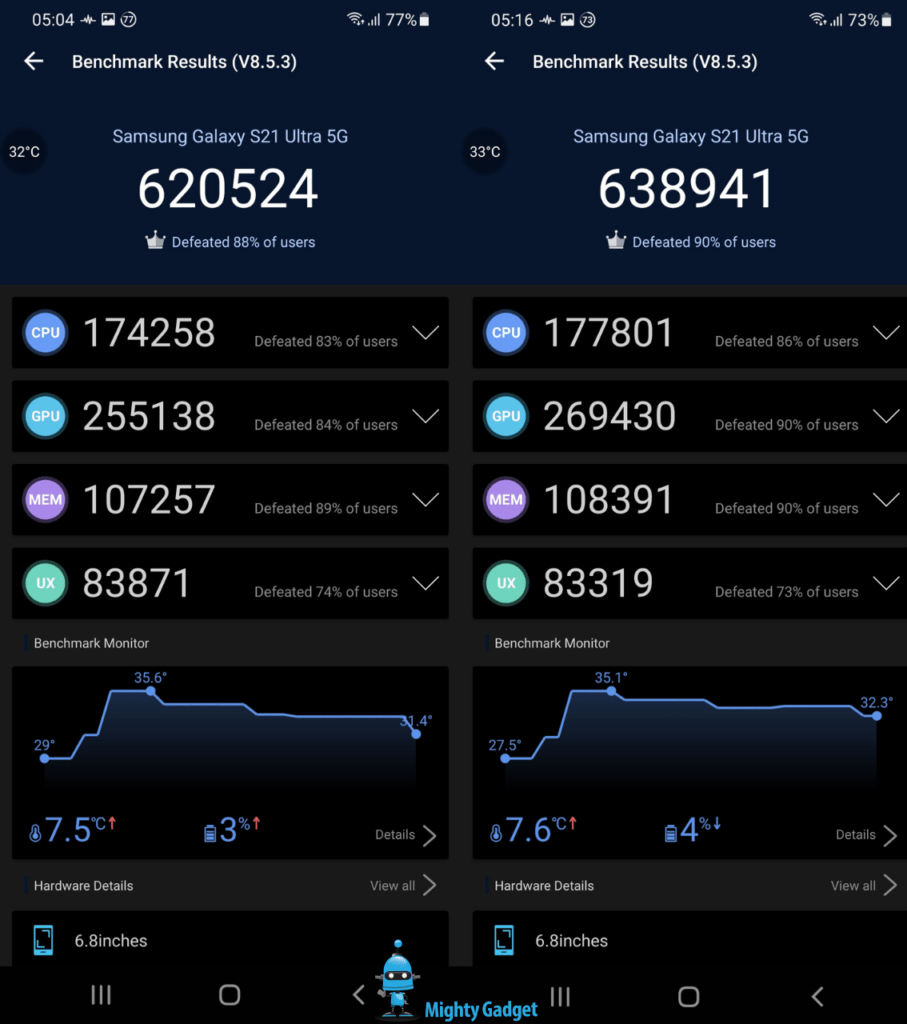
| Total | CPU | GPU | MEM | UX | Temp Increase | Battery Decrease | |
|---|---|---|---|---|---|---|---|
| Honor Magic5 Pro | 1092857 | 204878 | 540192 | 201695 | 146092 | 8 | 4 |
| Honor Magic4 Pro | 938464 | 197169 | 440631 | 148260 | 152404 | 10.7 | 5 |
| OPPO Find X5 Pro | 842660 | 166408 | 435209 | 111466 | 129577 | 7.5 | 5 |
| OPPO Find X3 Pro | 777229 | 192437 | 300378 | 137073 | 147341 |
I have mixed feelings towards the results; they are not exactly mind-blowing. If anything, I am not sure why it has scored some of the results.
The total score puts the Samsung Exynos 2100 in the last place for the 5nm chipsets used on phones in 2021, which is disappointing.
The odd part is that the CPU result is below both Huawei and Xiaomi Mi 11, but based on its specification it should have at least performed better than the Kirin 9000, and the frequencies used on the CPU indicate it should have performed better than the Qualcomm.
On the bright side, you have a 15% improvement in performance vs the last years Exynos 990 and the temperature increase and battery drain are lower than the Snapdragon 888.
Samsung Exynos 2100 vs Qualcomm Snapdragon 888 vs Exynos 990 Geekbench Benchmarks Compared
| Geekbench 5 | Chipset | Single Core | Multi Core |
|---|---|---|---|
| Honor Magic5 Pro | Snapdragon 8 Gen 2 | 1481 | 4932 |
| Honor Magic4 Pro | Snapdragon 8 Gen 1 | 1220 | 3569 |
| Xiaomi Mi 11 | Snapdragon 888 | 1139 | 3693 |
| OnePlus 9 Pro | Snapdragon 888 | 1109 | 3487 |
| Samsung Galaxy S21 Ultra | Exynos 2100 | 1079 | 3381 |
| Google Pixel 6 | Google Tensor | 1042 | 2957 |
| Xiaomi | Dimensity 8200-Ultra | 1005 | 3744 |
| OPPO Find X5 Pro | Snapdragon 8 Gen 1 | 976 | 3484 |
| Asus ROG Phone 3 S | Snapdragon 865+ | 975 | 3357 |
| Realme GT Neo 3 | Dimensity 8100 | 966 | 3672 |
| OPPO Find X3 Pro | Snapdragon 888 | 928 | 3357 |
| Realme X50 Pro | Snapdragon 865 | 910 | 3205 |
| Infinix Note 30 VIP | Dimensity 8050 | 854 | 3047 |
| Redmi K30 Ultra | Dimensity 1000+ | 782 | 2890 |
| Samsung Galaxy S20 | Exynos 990 | 772 | 2590 |
Geekbench results offer a similarly underwhelming experience. The Samsung Exynos 2100 falls short of the SD888, but at least beats the Kirin 9000.
Compared to the Kirin, that’s just a 5.7% difference for the single core, and 3.2% for multi core. The SD888 then sits 5.5% and 9.2% ahead of the Exynos.
The move from the Exynos 990 to 2100 offers impressive gains of 40% and 30%.
Samsung Exynos 2100 vs Qualcomm Snapdragon 888 3DMark Benchmarks Compared
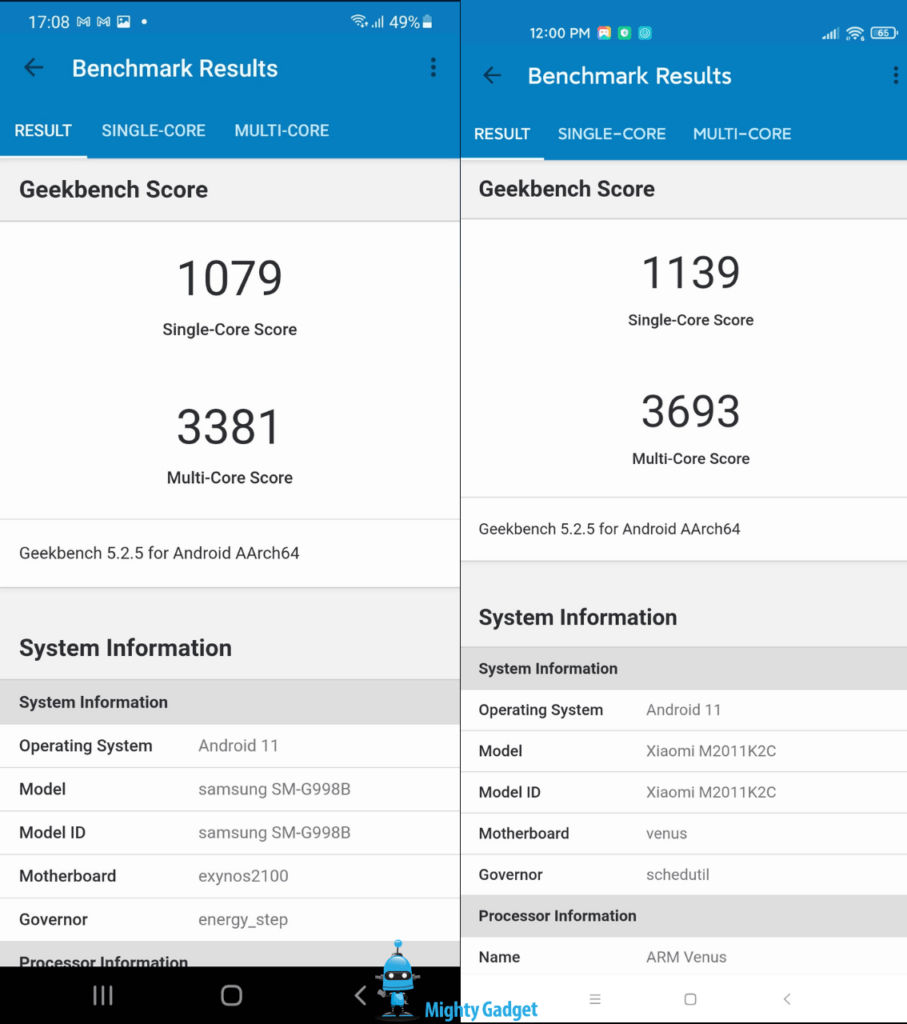
| Chipset | Sling Shot Extreme OpenGL | Sling Shot Extreme Vulcan | Wild Life | |
|---|---|---|---|---|
| OnePlus 9 Pro | Snapdragon 888 | Maxed Out | Maxed Out | 5775 |
| Samsung Galaxy S21 Ultra | Exynos 2100 | 7736 | 6467 | 5741 |
| Xiaomi Mi 11 | Snapdragon 888 | 8274 | 8182 | 5663 |
| Huawei Mate 40 Pro | Kirin 9000 | 9168 | 8401 | 5976 |
| Asus ROG Phone 3 | Snapdragon 865+ | 7645 | 7002 | 4127 |
| Realme X50 Pro | Snapdragon 865 | 3791 | ||
| Black Shark 3 | Snapdragon 865 | 7215 | 6606 | |
| Redmi K30 Ultra | Dimensity 1000+ | 6614 | 6143 | |
| OnePlus 7T | Snapdragon 855+ | 6278 | 5504 | |
| Black Shark | Snapdragon 855 | 5791 | 5030 |
Again, the Exynos 2100 lags behind, barely being ahead of the Qualcomm Snapdragon 865+ used on the Asus ROG Phone 3.
It is hardly a bad score, but the SD888 sits out in front by 7% and 26% for the two Sling Shot tests. The Kirin dominates this result thanks to its ridiculous 24-core GPU.
The Wild Life result paints a slightly rosier picture, placing the Exynos 2100 ahead of the SD888, but there is a serious problem with this result which I will cover in the later section where I have run the Wild Life stress test.
Samsung Exynos 2100 vs Qualcomm Snapdragon 888 PCMark Benchmarks Compared
| Performance Score | Work 3.0 Battery | |
|---|---|---|
| Honor Magic5 Pro | 14310 | 13h 38 mins |
| Honor Magic4 Pro | 14670 | 10h 32 mins |
| Samsung Galaxy S21 Ultra Exynos 2100 | 13638 | 12h 46min |
| Pixel 8 Pro | 12091 | 12 hours 56 mins |
| OPPO Find X3 Pro | 11932 | 9 hours |
| Pixel 7 Pro Tensor G2 | 11550 | 11h 39min |
| Pixel 6 Tensor | 11443 | 9h 45min |
Finally, the Exynos 2100 gets a win, though in one of the most inconsistent benchmarks I use. A win is a win though, and the Samsung scores 34% higher than the Xiaomi Mi 11.
I have only had the phone a day, so not had a chance to run the Work 2.0 Battery test, I plan to do this overnight, so will update the result this weekend.
Samsung Exynos 2100 Antutu & Wild Life Stress test thermals & battery drain

The Xiaomi Mi 11 launched with reports of problems with overheating and significant battery drain which led me to do a dedicated post comparing the SD888 and SD865 thermals and battery life.
The Antutu results for the Samsung Exynos 2100 are not quite as bad. Temperatures increase a lot more than the older SD865, but it’s lower than the SD888.
What is very concerning is the Wild Life Stress test. I thought the Xiaomi Mi 11 performed poorly offering a stability of 90.9% with its score dropping from 5550 to 5045.
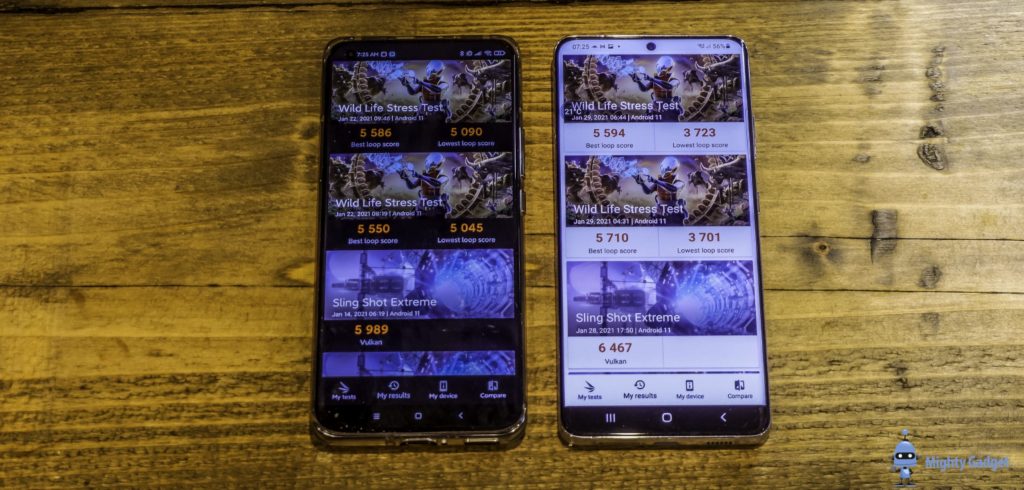
However, the Samsung suffers from severe throttling with a stability score of 64.8% and the result dropping from 5710 to 3701. This is only a 20 minute test, so for anyone gaming for prologued periods could, in theory, see a significant drop in performance.
This throttling then takes the results down to lower than the Realme X50 Pro scores for each one of its loops. That phone score almost perfectly consistent results.
The temperature didn’t increase quite as much as the Xiaomi going from 24°C to 42°C (Xiaomi went up to 46°C) and the battery only dropped 11% vs 15%, but the Samsung has a larger 5000mAh battery.
I have testing using the phone running all three resolutions and both 60Hz and 120Hz with no significant difference in results.
For the Xiaomi, I theorised that they could fix a lot of the issues by dialling back the performance a little to reduce overheating and battery drain. With this, I am not sure how much a firmware tweak could fix things.
Samsung Exynos 2100 vs Qualcomm Snapdragon 888 Storage Benchmarks
| Chipset | Seq Read MB/s | Seq Write MB/s | Rd Read | Rd Write | |
|---|---|---|---|---|---|
| Samsung Galaxy S21 Ultra | Exynos 2100 | 1478.92 | 1028 | 280 71855 IOPS | 239 61191 IOPS |
| Xiaomi Mi 11 | Snapdragon 888 | 1567 | 727 | 248 63581 IOPS | 284 72777 IOPS |
| Huawei Mate 40 Pro | Kirin 9000 | 2037.44 | 1321.01 | 324.97 | 277.65 |
| Asus ROG Phone 3 | Snapdragon 865+ | 1710.23 | 771.91 | 274.33 | 280.64 |
| Realme X50 Pro | Snapdragon 865 | 1770 | 763 | 250 64168 IOPS | 231 59206 IOPS |
| P40 Pro | Kirin 990 | 1807 | 392 | 221 56768 IOPS | 258 66295 IOPS |
| Redmi K30 Ultra | Dimensity 1000+ | 1562 | 714 | 246 55393 IOPS | 210 53850 IOPS |
I won’t dwell on the storage benchmarks much. They are good, most of the phones offer comparable results with each one offer better aspects in certain areas.
Samsung Exynos 2100 vs Qualcomm Snapdragon 888 Wi-fi Benchmarks
Lastly, the Wi-Fi performance, I have not tested this extensively, but last year the Qualcomm SD865 had Wi-Fi 6, but it could only use 80Mhz giving you a maximum theoretical speed of 1200Mbps.
The Kirin 980, used on the Huawei P40 Pro also had Wi-Fi 6 but could make the most of 160Mhz, giving a theoretical speed of 2400Mbps.
The new SD888 not only makes use of 160Mhz but features Wi-Fi 6E and the 6Ghz band. I don’t have a router to test Wi-Fi 6E, nor am I 100% sure if Xiaomi implemented it, but the phone can connect at 2400Mbps, but the throughput is lower than last years Huawei P40 Pro.
As for the Exynos 2100, I once again have poor results, but I think these should be easily fixed and could be an issue with my network.
Connecting to a Wi-Fi 6 access point at 80Mhz, the phone has no problem with establishing a link of 1200Mbps, though the actual throughput was on the lower end of what I would expect at 660Mbps.
Connecting to the Netgear RAX120 on 160Mhz, the phone initially reports 2.2Gbps but then drops down to 216Mbps. The SSID is 5Ghz only so it is not accidentally switching to 2.4Ghz. The Huawei P40 Pro and Xiaomi Mi 11 both have no problems connecting at over 1200Mbps with the Huawei achieving 1245Mbps on a LAN speed test.
Most people won’t be affected by these Wi-Fi benchmarks, but I cover a lot of Wi-Fi gear on Mighty Gadget so it is important to me.
Overall
With a shift to an all Arm design combined with matching fabrication processes, the Samsung Exynos 2100 was set up to offer comparable if not superior performance than the Qualcomm Snapdragon 888.
During my first set of benchmarks, for many of the results, this is not the case, at all.
Of course, this is two different phones from two different brands, so the results may not be 100% accurate, the physical design of the phone and the firmware will all play a part in the performance.
I hope both phones improve with firmware tweaks; the Xiaomi certainly needs to reign in its performance to improve the battery and temperatures.
Overall, it is early days in my testing; things may improve. I am not too concerned about the slightly lower benchmarks vs Qualcomm, I doubt I could ever tell the difference in real-life usage. However, the battery life and throttling issues remain a significant concern, and something that needs testing over a longer period.
I am James, a UK-based tech enthusiast and the Editor and Owner of Mighty Gadget, which I’ve proudly run since 2007. Passionate about all things technology, my expertise spans from computers and networking to mobile, wearables, and smart home devices.
As a fitness fanatic who loves running and cycling, I also have a keen interest in fitness-related technology, and I take every opportunity to cover this niche on my blog. My diverse interests allow me to bring a unique perspective to tech blogging, merging lifestyle, fitness, and the latest tech trends.
In my academic pursuits, I earned a BSc in Information Systems Design from UCLAN, before advancing my learning with a Master’s Degree in Computing. This advanced study also included Cisco CCNA accreditation, further demonstrating my commitment to understanding and staying ahead of the technology curve.
I’m proud to share that Vuelio has consistently ranked Mighty Gadget as one of the top technology blogs in the UK. With my dedication to technology and drive to share my insights, I aim to continue providing my readers with engaging and informative content.




